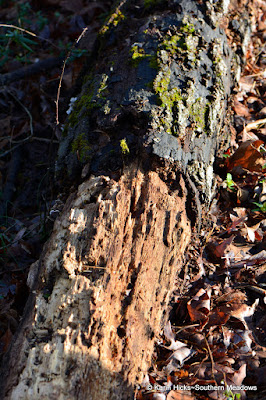Snags. They may just be the most alive tree in the forest.
Have you ever noticed how dead and decaying trees are actually teaming with life? There are several dead trees standing on our property. The forestry term for this is snag but a more deserving term is wildlife tree. This dead wood brings a lot of life to our garden, attracting wildlife that use them as nesting places, storage areas, for foraging, roosting and perching.
It usually starts with cavities excavated by woodpeckers, as they rarely use nesting boxes. Woodpeckers are made to dig. They have thick-walled skulls, powerful neck muscles, chisel like beaks and sharp feet with curved nails, which they use to skillfully construct holes for nesting.
 |
| Red headed woodpecker on a snag |
 |
| Downy woodpecker investigating an empty cavity |
They typically create several holes each season and rarely nest in the
same one twice. We have 7 different species of woodpeckers in our
garden, some are year-round residence and others seasonal.
As woodpeckers create new homes, the empty cavities become available for secondary cavity nesters such
as bluebirds, chickadees, nuthatches, house wrens, squirrels, bats, raccoons, opossums, flying squirrels and owls,
who can not excavate their own cavities.
 |
| fallen snag showing two nesting cavities |
Have you ever notice leaf nests high up in trees or bird houses stuffed with nesting materials in winter? Those are squirrel homes when cavities are not available. The survival of young squirrels in leaf nests is less than half that of cavity housed squirrels. Even snakes that shed their skin would rather slither into a safe cavity than be out in the open where they are vulnerable during the molting process.
 |
| dead bark nurtures insects which attract insect-loving birds |
The dead bark on decaying trees nurtures insects, which attracts insect-loving birds. Nuthatches, and woodpeckers eat bark beetles, spiders and ants that are found on the surface of the bark. Woodpeckers also find larvae and pupae of insects in the inner bark of snags and pileated woodpeckers dig down to the heartwood to prey on carpenter ants and termites. Snags are an open buffet for these birds.
The space between partially detached bark is where butterflies find shelter, often overwintering there. It also provides roosting slits for some songbirds and bats. The birds of prey that frequent our property (hawks and owls) are particularly fond of perching on top of one of the tall snag in our woods, allowing a clear view for hunting the land below.
The top of one of our snags came tumbling down in the wind the other day. The moss and fungi blanketing the trunk was already a clear sign that this snag was severely weakened and ripe for its next purpose. Think about it, these decaying trees and fallen logs may just actually be creating and influencing more organisms than the living trees.
 |
| soft snag covered in fungi and lacks limbs |
Skinks, fence lizards and tree frogs will take up residence in the soft wood, enjoying the cool wet temperatures found in these logs. Carpenter ants, wood-boring beetles and termites assist in breaking down the wood.
Squirrels and mice will hide nuts in the loose fibers. As the log continues to decay by fungus, microbes and insects it will eventually become humus providing a nutrient rich environment for seedlings to grow.
The fallen limbs that lay scattered on the forest floor can also provide a safe haven for quail, turkeys and other ground birds while cavities and nooks in standing trees provide places to animals and birds to sleep and escape from the elements. Snag loving mammals in our woods include bats, flying squirrels, fox, raccoon, opossum and gray squirrels.
 |
| tree cavities providing shelter for animals in our woods |
Snags are a natural feature that provide a unique environment for wildlife. To some gardeners dead and decaying trees may not be the most attractive of trees, but that all depends on your perspective. A snag can become a striking feature in your landscape with its interesting structure and texture. If you don't like the look of a dead tree or your HOA won't tolerate one, you can pretty it up by training a native vine to grow around it. For us, they ensure that our garden will remain filled with wildlife.











.png)
